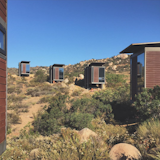Collection by Aileen Kwun
Builders, developers, designers, and architects have developed a range of homes that are composed of prefabricated, modular, or kit-of-parts pieces that can allow for lower costs, faster and easier on-site construction, and even higher quality spaces. Here, we delve into the differences—and similarities—among these manufactured residences.
The series of pitched white buildings was inspired by the work of architect Hugh Newell Jacobsen. “The shell of the house is a very simple form,” says Matthew Ford, “no turns or intersecting roof sections. This allowed me to use solid but inexpensive framing and roofing crews. We are always looking for the point where simplicity and luxury meet.”
Architect Jim Garrison of Brooklyn-based Garrison Architects was asked to design a retreat for visiting families on an idyllic lakeside expanse of land at a boarding school for troubled teens, Star Commonwealth in Albion, Michigan. To drastically reduce academic interruption and cut site noise, Garrison decided early on to create an 1,100-square-foot modular building dubbed Koby, with two bedrooms on opposite sides of the structure and a common dining area in the middle “as a therapeutic space for families to gather and eat together.”
"We wanted them to be silhouettes that just exist on the landscape," says Feilden Clegg Bradley and architect Charlotte Knight, who helped design The Study and The Workshop, a pair of mobile artist's studios currently located in South Downs, two hours drive south of London. "They’re black and foreboding. In the distance, it’s quite striking."
















